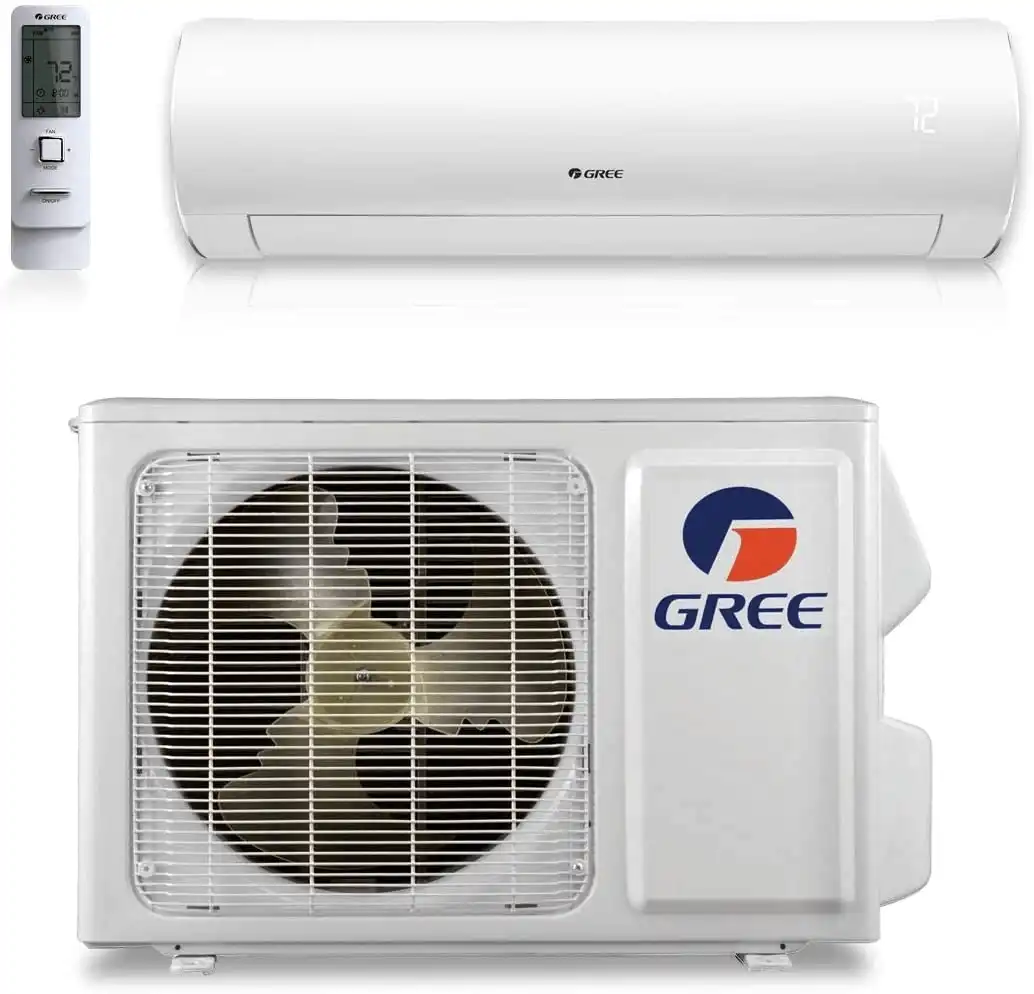
VRF Systems vs Mini-Splits for Zoning
When it comes to delivering precise temperature control, zoning is a game-changer for commercial HVAC systems. For HVAC contractors and building operators, choosing between VRF systems and mini-splits is a critical decision that impacts comfort, efficiency, and operational costs. Both systems offer solutions for creating independent zones, but each is tailored to specific building sizes and needs.
Failing to select the right system could lead to wasted energy, higher expenses, and dissatisfied occupants. In this article, we'll break down the key differences between VRF systems and mini-splits, helping you navigate their features, advantages, and limitations. Whether you're designing comfort systems for a multi-story office or retrofitting a small commercial space, understanding how GREE Comfort's VRF and Multi-Zone systems differ will help you choose the right solution. Plan your next zoning project with the GREE's System Builder tool.
VRF Systems for Zoning
VRF systems are designed to independently manage heating and cooling in different commercial zones. Using refrigerant for heat transfer, these systems adjust to the specific heating or cooling needs of each zone, allowing for simultaneous temperature control across various areas. This precise approach ensures that each zone's thermal requirements are met efficiently, making VRF systems particularly effective in buildings with varying occupancy or changing temperature demands. Their adaptability makes them an excellent choice for dynamic commercial spaces.
VRF System Features
VRF systems are ideal for large commercial spaces that require individualized climate control. They connect multiple indoor units to a single outdoor unit, making them suitable for office buildings, hotels, retail spaces, and mixed-use developments. Their flexible refrigerant piping allows for easy adaptation to complex layouts and long-distance installations.
A standout feature of VRF systems is the inclusion of centralized smart controls. These controls allow for real-time temperature adjustments, energy monitoring, and scheduling, often integrating seamlessly with building management systems. This centralized functionality not only simplifies system operation but also enhances energy efficiency and overall performance.
Another notable advantage is the ability to provide simultaneous heating and cooling, tailoring conditions to the immediate needs of each zone. Additionally, the modular design of VRF systems supports phased installations and future expansions without requiring significant changes to the existing infrastructure.
GREE VRF systems, such as the GMV5 Mini and GMV6 Heat Recovery series, use inverter and Enhanced Vapor Injection (EVI) technology for reliable performance, even in cold U.S. climates. The system continuously adjusts compressor speed to match the demand, maintaining efficiency and comfort.
VRF System Pros and Cons
VRF systems bring a range of benefits to complex, multi-zone commercial environments. Their variable-speed operation and integrated heat recovery contribute to greater energy efficiency. The ability to control temperatures precisely in individual zones enhances comfort while preventing energy waste in unoccupied or less critical areas. Scalability is another key advantage, as these systems can easily accommodate building expansions or layout changes with minimal disruption.
However, these benefits come with some challenges. VRF systems typically involve higher upfront costs. Their installation requires certified HVAC technicians experienced in refrigerant piping. Additionally, maintenance and troubleshooting can be more complex, often necessitating specialized training or service contracts to ensure optimal performance. GREE offers contractor training and support programs to streamline installation and ensure system reliability.
Despite these challenges, VRF systems deliver significant value in settings where zoning flexibility, precise climate control, and energy efficiency are essential. Manufacturers like GREE Comfort are continually improving installation processes and support services, making VRF systems an increasingly appealing option for commercial applications.
Mini-Splits for Zoning
For businesses looking for a practical and efficient way to manage zoning in smaller commercial spaces, mini-split systems offer a straightforward alternative to more complex VRF setups. These systems are well-suited for spaces that don't require the extensive infrastructure of VRF systems. A mini-split setup typically connects a single outdoor unit to multiple indoor units, serving 1 to 5 zones per outdoor unit. This makes them an appealing option for businesses that prioritize simplicity and cost savings over the complexity of larger-scale systems.
Mini-split systems are especially useful in commercial settings like small retail stores, offices, restaurants, and medical facilities. They allow for precise temperature control in individual zones, ensuring comfort and efficiency. For instance, a dental office can maintain a comfortable 72°F in patient areas while keeping an equipment room at a cooler 68°F.
GREE Comfort's multi-zone mini-split systems are designed for these applications, featuring inverter technology that adjusts compressor speed based on demand. This technology not only ensures consistent comfort but also reduces energy consumption, aligning with both economic and environmental goals.
Mini-Split Features
Multi-zone mini-splits are built for flexibility, connecting one outdoor unit to several indoor units, each with its own thermostat. This setup allows for individual temperature control in different zones, which is especially valuable for businesses with varying needs across their spaces.
The installation process is notably simpler compared to VRF systems. Mini-splits require only refrigerant lines, electrical connections, and drainage for condensate between the indoor and outdoor units. This simplicity translates to lower labor costs and faster installation, making them accessible to a wider range of businesses.
GREE MultiPRO and Multi21+ systems include built-in Wi-Fi connectivity and app-based smart controls. While these controls may not match the centralized integration of VRF systems, they provide enough functionality for small to medium-sized commercial spaces. Users can remotely adjust temperatures, set schedules, and monitor energy use through user-friendly interfaces. Contractors can watch step-by-step configuration on GREE's instructional videos page.
GREE Comfort's mini-splits are equipped with EVI technology, allowing them to perform reliably in cold climates, even when outdoor temperatures drop to -13°F. This makes them suitable for year-round use across the United States, often eliminating the need for additional heating systems.
The modular design of mini-splits also allows for phased installations and future expansion. Businesses can start with the most essential zones and add more indoor units as their needs grow, provided they stay within the capacity of the outdoor unit. This scalability is particularly useful for businesses with evolving requirements or seasonal operations.
Mini-Split Pros and Cons
Mini-split systems are known for their affordability and ease of use. Their lower upfront costs make them a practical choice for small businesses or projects with limited budgets. Installation is simpler than that of VRF systems, which further reduces costs and simplifies servicing, but it must still comply with IMC and NEC standards, including proper circuit sizing, disconnect placement, and condensate management.
One of the standout advantages of mini-splits is their energy efficiency. These systems often achieve SEER ratings above 20, and their variable-speed compressors adjust output to meet real-time demand. This eliminates the energy waste associated with constant on-off cycling, resulting in lower operating costs and more consistent comfort.
Another benefit is their quiet operation. Indoor units typically run at noise levels below 40 decibels - similar to a quiet library - while outdoor units are designed to minimize noise, making them suitable for professional environments where silence is appreciated.
However, mini-splits do have scalability limitations, which can be a drawback for larger commercial projects. Most systems are capped at 5 indoor units per outdoor unit, and their overall capacity is limited compared to VRF systems. For buildings requiring extensive zoning, multiple outdoor units may be necessary, which could pose space and aesthetic challenges.
Integration with building automation systems is another area where mini-splits fall short compared to VRF solutions. While modern mini-splits offer smart controls, they don't integrate as seamlessly with centralized building management systems. This may be a concern for facility managers who need comprehensive monitoring and control across multiple systems.
Maintenance needs are relatively straightforward due to their simpler design, but having multiple outdoor units can increase the overall maintenance workload. Each unit requires separate attention for tasks like coil cleaning and refrigerant checks, which could complicate servicing in multi-unit setups.
Despite these challenges, mini-splits remain an excellent choice for businesses prioritizing simplicity, cost savings, and reliable performance. GREE Comfort continues to refine their mini-split systems with features like advanced filtration, enhanced cold-weather capabilities, and improved control options, bridging the gap between basic systems and more advanced commercial solutions.
VRF Systems vs Mini-Splits Comparison
Selecting the right system depends on factors like site size, control needs, and budget. VRF systems are ideal for larger, more complex setups, while mini-splits shine in smaller spaces with simpler requirements.
VRF systems are designed for large-scale, centralized applications, offering seamless multi-zone control. In contrast, mini-splits provide a straightforward and cost-effective solution for smaller areas.
Side-by-Side Comparison Chart
| Feature | VRF Systems | Mini-Splits |
|---|---|---|
| Zone Capacity | Handles a wide range of zones for centralized control | Best suited for limited zone setups |
| Building Size | Optimized for large commercial spaces | Ideal for small to mid-size buildings |
| Installation Complexity | Requires specialized expertise | Easier to install |
| Upfront Cost | Higher initial investment | Lower upfront cost |
| Control Integration | Advanced integration with building management systems | Effective standalone smart controls |
| Energy Efficiency | High efficiency with heat recovery options | Maintains efficiency with advanced compressors |
| Maintenance | Needs specialized servicing | Standard HVAC maintenance suffices |
| Scalability | Easily scalable for multi-zone expansion | Expansion may involve adding more units |
| Cold Weather Performance | Features for enhanced cold climate performance | Reliable operation in colder conditions |
| Noise Level | Quiet and unobtrusive operation | Low indoor noise levels |
This comparison highlights the strengths of each system, helping you make an informed decision based on your project needs.
How to Choose Between VRF and Mini-Splits
When deciding between these systems, keep the following factors in mind:
- Building Size and Layout: Larger commercial spaces benefit from the scalability and zoning capabilities of VRF systems. Mini-splits are better suited for smaller, static layouts.
- Budget: VRF systems involve a higher upfront cost and require specialized installation and maintenance, while mini-splits are more budget-friendly initially and simpler to service.
- Control Integration: For properties with advanced building management systems, VRF systems offer seamless integration. Mini-splits, on the other hand, provide effective, standalone smart controls for facilities without extensive automation.
- Climate: GREE's EVI technology allows reliable performance for both VRF and multi-zone mini-splits, ensuring year-round heating across U.S. climate zones.
- Service Availability: VRF systems need technicians with specific training, while mini-splits can typically be maintained by standard HVAC professionals. Consider the availability of skilled technicians in your area.
Ultimately, the choice between VRF systems and mini-splits depends on the unique needs of your project. GREE Comfort offers a wide range of products designed to provide efficient and scalable zoning solutions, ensuring you can meet the demands of any commercial application.
Real-World Applications and GREE Comfort Solutions
Expanding on the system comparison, practical applications highlight how these systems perform in diverse commercial environments. The effectiveness of each technology depends on factors like building design, usage patterns, and operational needs.
VRF and Mini-Split Use Cases
For multi-story office buildings, VRF systems are a standout choice. These systems allow for simultaneous heating and cooling across various zones, delivering precise temperature control. This makes them ideal for corporate offices, medical facilities, and schools, where different areas often have unique occupancy schedules and temperature demands.
On the other hand, mini-splits are a smart, economical option for smaller retail spaces and commercial buildings. They work well in strip mall stores, restaurants, and professional offices, offering excellent climate control without the complexity of centralized systems. Mini-splits are especially useful for renovation projects where ductwork is limited or nonexistent, allowing businesses to upgrade their HVAC systems without significant structural changes.
Mixed-use developments often call for a combination of both systems. For example, GREE MultiPRO systems for ground floor retail spaces and GREE VRF GMV6 for upper floors. This hybrid approach optimizes energy use while tailoring comfort to the specific needs of each space. Contractors can use the System Builder app to design hybrid zoning layouts.
In the hospitality sector, boutique hotels often prefer mini-splits for their ability to provide individual room control and easy maintenance. Larger hotels, however, benefit from VRF systems, which can integrate with building management systems for centralized monitoring and control. These varied applications emphasize the importance of customized zoning solutions, such as those offered by GREE Comfort.
GREE Comfort Zoning Products
GREE Comfort offers a range of HVAC products designed to meet both small-scale and large commercial zoning needs. Their smart, WiFi-enabled systems ensure complete control and monitoring, making them adaptable to projects ranging from single retail spaces to complex commercial developments.
The MultiPRO Systems provide a versatile solution, supporting up to 10 zones with a single outdoor unit. These systems are perfect for mid-sized projects where full VRF systems may not be necessary but independent zone control is still a priority. They balance the simplicity of mini-splits with the precision of VRF systems.
For larger commercial projects, GREE Comfort's VRF systems deliver advanced heating and cooling capabilities with variable refrigerant flow technology. These systems integrate seamlessly with building management systems, offering scalability for multi-story buildings and intricate layouts. For spaces with tighter constraints, GREE Comfort's packaged units offer a compact, all-in-one option, addressing zoning challenges effectively.
GREE Comfort also supports contractors with extensive technical documentation and specialized diagnostic tools. Their contractor support programs provide access to training resources, technical assistance, and system design guidance, ensuring smooth installations and reliable performance over time.
Additionally, GREE Comfort's smart controls enable remote monitoring, scheduling, diagnostics and energy management. These consistent controls simplify training and create a unified user experience across various building types, making them a practical choice for both contractors and end-users. Contractors can find setup guides in the Instructional Videos and FAQ sections.
Conclusion
When deciding between VRF systems and mini-splits, it's essential to consider the size and complexity of the space. VRF systems are ideal for large, intricate environments like multi-story office buildings, hotels, and medical facilities. These systems provide high-capacity performance with the ability to heat and cool simultaneously, all while integrating seamlessly with building management systems for centralized monitoring and scheduling.
On the other hand, mini-splits are well-suited for smaller spaces and budget-conscious projects. Designed to handle 1–5 zones independently, they are a practical choice for retail stores, restaurants, and professional offices. While they lack the advanced refrigerant flow modulation of VRF systems, mini-splits offer straightforward and efficient performance for less complex setups.
Factors like building size, budget, and future expansion plans play a key role in determining the best system. For buildings requiring capacities over 25 tons, VRF systems deliver the scalability and precise control necessary for optimal functionality. Meanwhile, smaller commercial spaces can benefit from the simplicity and independent zone control provided by mini-splits.
GREE Comfort offers a wide range of solutions to meet diverse commercial needs. Their product lineup includes everything from single-zone mini-splits to sophisticated VRF systems, such as the MultiPRO Systems, ensuring there's a zoning solution for every project. With advanced smart controls, comprehensive contractor support, and a reputation for reliability, GREE Comfort provides the tools and expertise to create efficient and comfortable commercial environments.
Contractors can access detailed system documentation at System Documentation and design tools at System Builder tools. Property owners seeking professional installation can connect with certified technicians through GREE Contractor Locator to ensure their systems perform efficiently and reliably for years to come.
FAQs
What should I consider when choosing between VRF systems and mini-splits for my commercial building?
When choosing between VRF systems and mini-splits for your commercial building, it's essential to consider the size of your space and how you plan to divide it into zones. VRF systems are well-suited for larger buildings with multiple zones, as they can heat and cool different areas at the same time. Mini-splits, on the other hand, are more appropriate for smaller spaces or individual zones that require straightforward temperature control.
Budget and long-term objectives also play a key role in the decision. While VRF systems usually involve a higher upfront cost, they offer better flexibility, energy savings, and the ability to scale for more complex setups. Mini-splits, though more affordable initially, might not be as practical for larger or more intricate layouts. Take the time to evaluate your building's unique needs to choose the option that aligns best with your goals.
What are the differences between VRF systems and mini-splits in energy efficiency and operating costs?
VRF systems can deliver significant energy savings through demand-based refrigerant control, reducing consumption by up to 50% under optimal conditions compared to constant-speed systems. Although the upfront costs for installing VRF systems are higher, their precision in managing energy use often offsets the initial investment in the long run.
In contrast, mini-splits are generally more budget-friendly to install and come with a simpler setup process. However, they don't offer the same advanced energy management capabilities as VRF systems, which can result in higher energy expenses over time. For projects where long-term efficiency and the ability to scale are key considerations - especially in larger commercial spaces with varied zoning requirements - VRF systems often prove to be the smarter option.
Can mini-split systems connect to building automation systems for easier control?
Yes, mini-split systems can work alongside building automation systems (BAS) to enhance control and monitoring capabilities. Using advanced controllers like GREE Comfort's MultiPRO, these systems can connect through widely-used protocols such as BACnet and Modbus, ensuring smooth communication with your BAS.
This setup allows for centralized management of HVAC operations, helps lower energy usage, and provides remote monitoring options. It's a practical choice for improving HVAC efficiency in commercial spaces.




